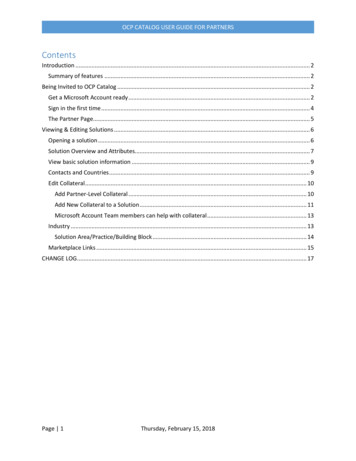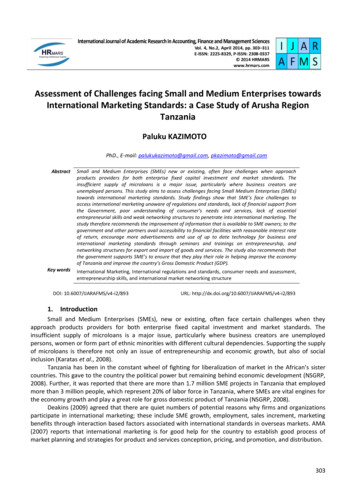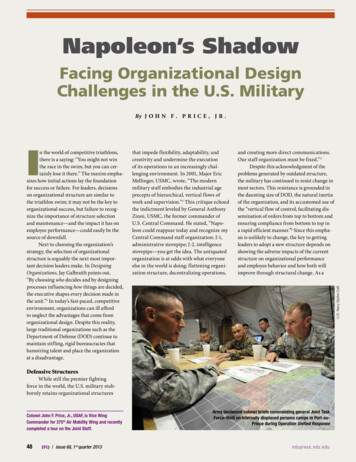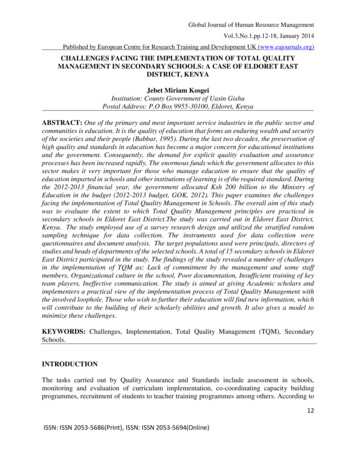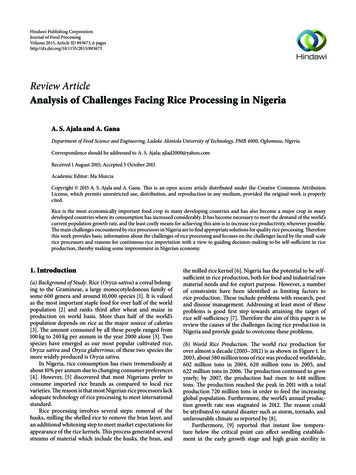
Transcription
1RESEARCH DIRECTIONSUnderstanding the different challenges facingstudents in transitioning to university particularlywith a focus on ethnicityHannah Parker1, Annie Hughes3, Caleb Marsh1, Sadia Ahmed1, James Cannon2, EmmaTaylor-Steeds3, Lucy Jones1 & Nigel Page1,*School of Life Sciences, Pharmacy and Chemistry1; Education Liaison and Outreach2; Equality,Diversity and Inclusion Centre3; Kingston University London*Corresponding Author: N.Page@kingston.ac.ukKeywords: Transition, widening participation, ethnicityAbstractIntroductionA positive and successful transition intoUniversity is crucial if students are to stay thecourse in higher education and experiencesuccessful outcomes. However, challengesexist in ensuring a connected transition fromsecondary and further education to highereducation that is inclusive and supports thediversity in our current undergraduate studentbody. We set out to explore the diverseexperiences that first year students reportabout their recent transition to a post-1992University. We were particularly interested inhow these experiences and challengesdiffered by ethnicity. This is incrediblyimportant given the disparity, recognised inthe sector, in the attainment of Black andMinority Ethnic (BME) students compared totheir White counterparts and particularlypertinent that this trend reverses attainmentpatterns in secondary education. This papersummarises some of our key findings indetermining the challenges facing studentsfrom different backgrounds in their transitionto university. It argues that Universities willhave to change their transition and wider offerto ensure that diverse students feel welcomedand develop a sense belonging in HigherEducation in order for them to achievesuccessful outcomes.There are many academic and non-academicobstacles that students must overcome whentransitioning from School/Further Education(FE) to Higher Education (HE). Although thefirst year of university can be an exciting timefor students, it can also be the mostchallenging in terms of personal adjustment.A positive and successful transition intoUniversity is crucial if students are to stay thecourse in higher education and experiencesuccessful outcomes. However, we know thatdifferent groups of students have differentialexperiences and outcomes based on anumber of socio-cultural and economicdifferences. Central to the purpose of thispaper is the growing body of evidence whichhighlights that students coming from Blackand Ethnic Minority backgrounds have lesssuccessful outcomes in higher education.HEFCE (2015) reports that the differencebetween White and BME graduates is 16percentage point (76 compared to 60). Thisgap reduced by only 1 percentage point whena range of factors were controlled such asage, disability status, subject of study, priorattainment and so on. HESA data (2014/5)from some of our own courses for example inpharmaceutical science and biochemistryindicated lower VA scores (0.44, 0.46, lessthan the optimum 1, where VA, represents theNew Directions in the Teaching of Physical Sciences, Volume 12, Issue 1 (2017)doi: XXXXXXX
2Understanding the different challenges facing students in transitioning to university particularly with a focus on ethnicitydifferences in attainment set against expectedtargets). Therefore, whilst the attainment gaphas decreased from its peak of 18.8% in2005/06 (Equality Change Unit, 2014), thegap in attainment remains considerable. Thisgap in degree performance has becomeknown across the HE sector as the ‘BMEattainment gap’. The underperformance ofBlack and Ethnic Minority students in highereducationcontrastssignificantlywithacademic achievement patterns of pupils insecondary education, where all Black,Minority Ethnic (BME) groups, except forBlack boys, outperform White pupils in GCSEattainment (Department for Education, 2016).BME students are also substantially morelikely to go to university than their Whitecounterparts (Crawford & Greaves, 2015).Kingston University has a significant numberof BME students (51% of all students and upto nearly 90% on some science courses) withmany courses having their own distinct ethnicand gender make up.The question arises about the role oftransition into higher education and howdifferent groups of students experience theevolution from school or college to highereducation. Simultaneously, questions areraised about the preparedness of universitiesto ensure that students from diversebackgrounds feel welcomed and are preparedfor study in higher education institutions.Feelings of belonging are fundamental to apositive leaning experience (Read, 2003) andtherefore a successful transition (Frame,2015). Indeed, existing work around the BMEattainment gap and differential attainmenthighlights the importance of students’ senseof belonging and the positivity of their dailyinteractions within their institutions as centrallyimportant in achieving successful outcomes(HEFCE, 2015b). Making friends andencouraging relationships with peers and staffare recognised components of belonging(Read et al. 2003; Thomas, 2012). Theimplication here is that BME students do notfeel the same sense of belonging as theirWhite peers and, more significantly, thatHigher Education Institutions are potentiallynot taking sufficient steps to ensure that theirenvironments are inclusive and that theywelcome and encourage BME students to feelthat they belong.The period of transition to university is a keymoment where a sense of belonging can beengendered (Thomas, 2012). This projectaims to explore the differential experiencesand expectations of White students andstudents coming from Black and MinorityEthnicbackgroundswhohavejusttransitioned into higher education in a post-92London University. It examines theirchallenges and asks if the University is doingenough to ensure that the transition touniversity is successful for all students.MethodologyAn ethically approved (Kingston UniversityCentre for Higher Education Research &Practice Ethics Panel) paper-based surveywas developed that included the fundamentalresearch questions alongside demographicdata. The survey was piloted with a smallgroup before being completed by a widercohort during their classes. This cohortcomprised undergraduate students at level 4(1st year) who were studying a range chemistry,pharmacology,biomedical science, nutrition, pharmaceuticalscience and pharmacy) within the School ofLife Sciences, Pharmacy and Chemistry.Surveys were anonymous. Numerical datawas then extracted and managed usingPowerBi pivot tables, where the output wastabulated or displayed graphically.To support the quantitative findings, two focusgroups were organised to generate qualitativedata. A total of 12 participants from both BMEandWhitebackgroundsparticipated.Respondents attended for a one hour session.Participants were then asked first to respondto a list of pre-designed questions by writingtheir thoughts on post-it notes and placingthem in the middle of the table. The questionwas then reiterated and discussed as a group,with the main themes being recorded by anote-taker. At the end of the session, post-itnotes were collected with the permission ofthe participants, and used for later reflectionalong with the notes taken during the groupdiscussion.New Directions in the Teaching of Physical Sciences, Volume 12, Issue 1 (2017)doi: XXXXXXX
3Understanding the different challenges facing students in transitioning to university particularly with a focus on ethnicityFigure 1 A comparison of the motivators for deciding to attend university.(78.6%) that university would indeed improvetheir career prospects.ResultsRespondent CharacteristicsA total of 316 undergraduate studentscompleted the survey. Of the collectedsurveys, 20 were removed owing to theparticipants having international qualifications.Surveys which did not declare their ethnicitywere also removed. The final data setconsisted of 289 surveys.
Understanding the different challenges facing students in transitioning to university particularly with a focus on ethnicity New Directions in the Teaching of Physical Sciences, Volume 12, Issue 1 (2017 ) doi: XXXXXXX 2 differences in attainment set against expected targets). Therefore, whilst the attainment gap has decreased from its peak of .



